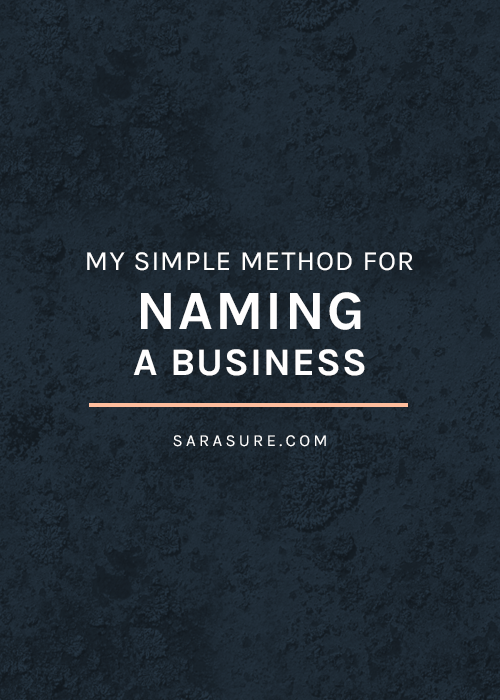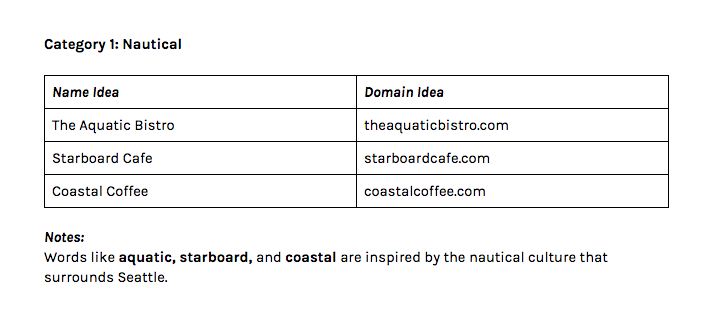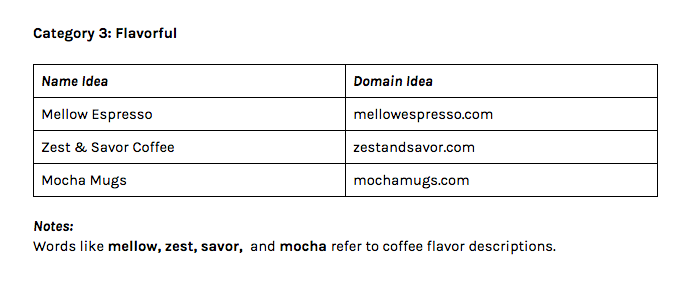
My Simple Method For Naming a Business
By Sara StuartWhen you first start a business, the struggle to come up with the perfect name that’s agreeable to you and your audience is certainly real. This name will mark the beginning of your company's culture, your brand, and it will follow you into the foreseeable future, so no pressure right? Believe me, I've been there and I have put forth my time in research, brainstorming sessions, list making, and multiple elimination processes, so I can tell you that it’s no easy feat.
So if you feel overwhelmed with research or lost with no clue on where to begin, here’s my simple method for naming a business.
1. Get to Know Yourself and Your Business
In order to come up with a great name that communicates who you are and what you do as a business, you need to dig deep and brainstorm some initial keywords. To begin, ask yourself these questions:
- What do you want to communicate to your potential customers?
- What are some of the main keywords in your industry? (Think about what you do and some of the services you offer.)
- What makes you valuable and different from your competitors?
- Who is your ideal audience? (Be as specific as possible. Include age range, gender, salary range, industry, etc.)
- What are some of your business’s main personality traits? (Examples: social, easygoing, smart, multifaceted, loyal, etc.)
- What are 4 descriptive words that you want others to associate with your brand? (Examples: cheerful, classic, friendly, adorable, witty, modern, timeless, industrious, sincere, energetic, etc.)
2. Brainstorm Your Root Words
Take a look at your answers to the questions above and develop a list of words. This initial list will be considered your root words and are determined by two factors: literal and figurative.
Literal: Literal words are the basic, straight-forward terms that are associated with your industry, like products and services. So if I had coffee shop in Seattle, mine would most likely be: bistro, cafe, coffee, and espresso.
Figurative: The figurative words would stem from the descriptions of the literal. This means that they could be names, objects, phrases, moments, feelings, etc. Anything is possible in this category, as long as it makes sense to your targeted audience. Using the same example above, some of my descriptive words for my coffee shop would be: aquatic, wired, mellow, and zest.
My resources for root word research
- The Thesaurus: I use a Thesaurus for practically everything and root word research is no exception. This tool is awesome for developing figurative words from literal ones. Don’t forget to check out the synonyms!
- A Latin Dictionary: Have you ever noticed that most of the spell names from Harry Potter are based from Latin terms? Take a cue from J.K. Rowling and look into an online Latin dictionary.
- Music Lyrics: Music is a powerful thing. It has a way of making people feel things they wouldn't normally feel through cleverly arranged phrases, descriptive words, and cryptic song titles.
- Geography: Are there any specific places that you're inspired by, have lived in, or are marketing your business in? If so, try researching some names within that area and see what you find.
- Historical References: Look up the history of your profession and see if you can uncover any leads. Better yet, look up the history of every root word you like.
- Personal and Professional Influences: Explore and research your other interests. Whether it’s a specific person or company, philosophy/idea, movement, era, etc., it will give you a fresh perspective.
- Google & Wikipedia: For definitions or pop culture references on root words, these are two great sources.
- Glossaries: Hit the books at your local library and browse through the glossary of terms for ideas.
- Image Searches: Sometimes inspiration can strike just by looking at a bunch of photos relating to your theme or concept. Take a look at Pinterest, Google Images, and stock image sites.
Naming Rules of Thumb
- Make it meaningful and positive. The right name should evoke an idea of what your business stands for and the emotional meaning you'd like to convey. Think of something that conjures up positive memories and images.
- Keep it simple and as short as possible. If it’s too complicated, no one’s going to understand it except for you. Stay away from using industry terms that only you will know.
- Stay away from trends. It’s okay to research your competition, but it’s also important to fight the temptation of creating a similar name and fall prey to naming trends. Ask yourself, do you want to fit in or stand out and gain a competitive advantage?
- Provide a clue to what you do. Consider a tagline to go along with your main business name so your line of work is clear to others. Whether it’s the main name or the tagline, you should include a name that conveys the purpose of your business to others. (ex. Sarasure Design Co.) The more it communicates about your business, the less you'll have to explain.
- Don't limit yourself. Think about the future and where you'd like your business to be. It’s okay use descriptive words, but don't go too far and box yourself in.
- Remember your targeted audience. Refer back to your business’s goals and vision and aim at reinforcing those key elements when you think of names. Will your audience understand a name if it’s misspelled or from a foreign origin? Will they be able to pronounce it easily?
- Research, research, research! This is especially important because it can save you from potential language pitfalls. For example, in 1995 Reebok redirected their targeted audience to women and named one of their shoes “Incubus.” This term has been known to mean “a mythical demon who has intercourse with women in their sleep.” Don't let a similar mistake like this happen to you and your business!
- Avoid: Annoying, random words with an absence of meaning, awkward puns, and double entendres.
- Don't get too attached to names. During the brainstorming process, it’s important to be open to new ideas and not to get hung up on certain names in particular. It’s often harder to tell if a name fits your business if you're too attached to it.
-
Make sure the name is available. You can do so through three different steps:
- Run a Trademark search.
- Secure a .com domain by making sure it’s available through who.is.
- Secure your social media profiles (once you've finalized a name).
3. Mix & Match Words
Next, take your list of root words and start combining them to form a new list of possible business names. Using my previous example about the coffee shop, here are some possible combinations: The Aquatic Bistro, Mellow Espresso, Zest & Savor Coffee, and The Wired Cafe.
This stage of the process should be fun and unlimiting. Think about each word and rearrange them with words that flow together and make sense for your business’s goals and vision. If you need a reminder of this, reference the answers to the six questions you answered about your business at the first stage.
If you need more ideas on how you can mix and match your root words, The Name Inspector has a fantastic article on 11 different types of names and the pros and cons of each.
4. Categorize Your Names
If you've done the second and third stage correctly, you should have a bunch of terms that reflect multiple themes, tones, and feelings. Once you have a wide variety of options, the following step is to organize your findings by separating these into categories. This will result in your third and final list.
Like the mix and match stage, there is no right or wrong way to organize your list of words. Some could be arranged by key themes, while others could be arranged by name types (outlined by The Name Inspector). Personally, I like to outline by theme. For example, my fictional coffee shop’s would look like this:



5. The Elimination Process
Take a look at your newly organized list of ideas and start highlighting your favorites. Before you show anyone else your top choices, take a minute and ask yourself these questions:
- Which one fits your company’s description the best?
- Which one best fits your long and short-term goals?
- Does it accurately tell your company’s story?
- Does the imagery associated with the name seem appropriate?
- Will it attract your ideal audience?
- Does the URL look weird?
If a name does not pass all of these questions, eliminate your idea right away. Use the names that surpass these questions, and try some of these additional ideas:
- Ask someone you trust. Start off by asking for a first impression from someone you can count on giving an honest answer. Once they provide you with an opinion, inform them on what your business does and what you're trying to accomplish and ask if that name conveys this message.
- Take a poll from your ideal audience or a small, select group of friends and family. Look at online discussion groups, forums, or select social media networks. Just don’t include too many people since this tends to hold up the process and will have you rethinking all of your ideas. There’s a reason why the phrase “too many cooks in the kitchen” exists.
- Say it aloud. Practice saying your name as if you're introducing yourself to a client or contact. Sometimes the sound of a name can feel suggestive or tough to say.
- See what it will look like on business stationery and signs. Type out your name ideas onto a design template or ask a friend to create a mock-up. Sometimes it’s helpful to have a visual.
Deciding on a business name can be just as trying as coming up with ideas for one. However, once you select one, it’s important to give yourself some time to adjust. You may have second thoughts or feel like you should go back to the drawing board, but you must remember to resist this urge and wait for it to sink in. If you're worried that your name is too unique and varies greatly from your competitor’s, have no fear. I'm sure Google had a similar feeling and look how well that worked out for them.
